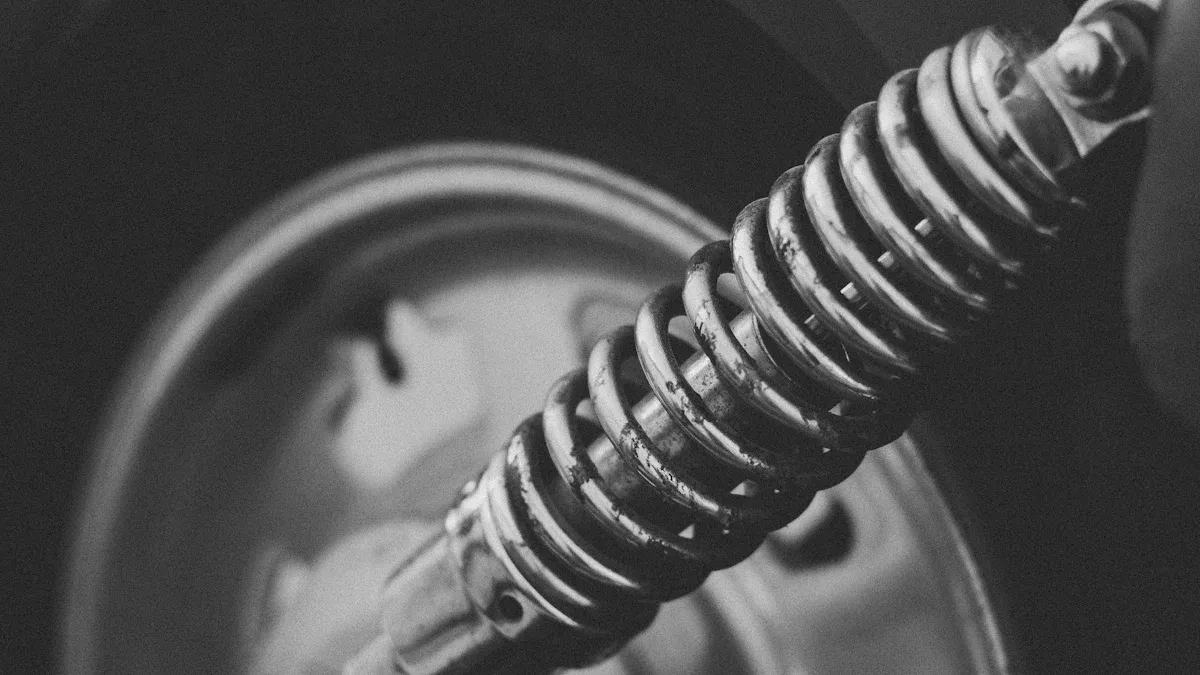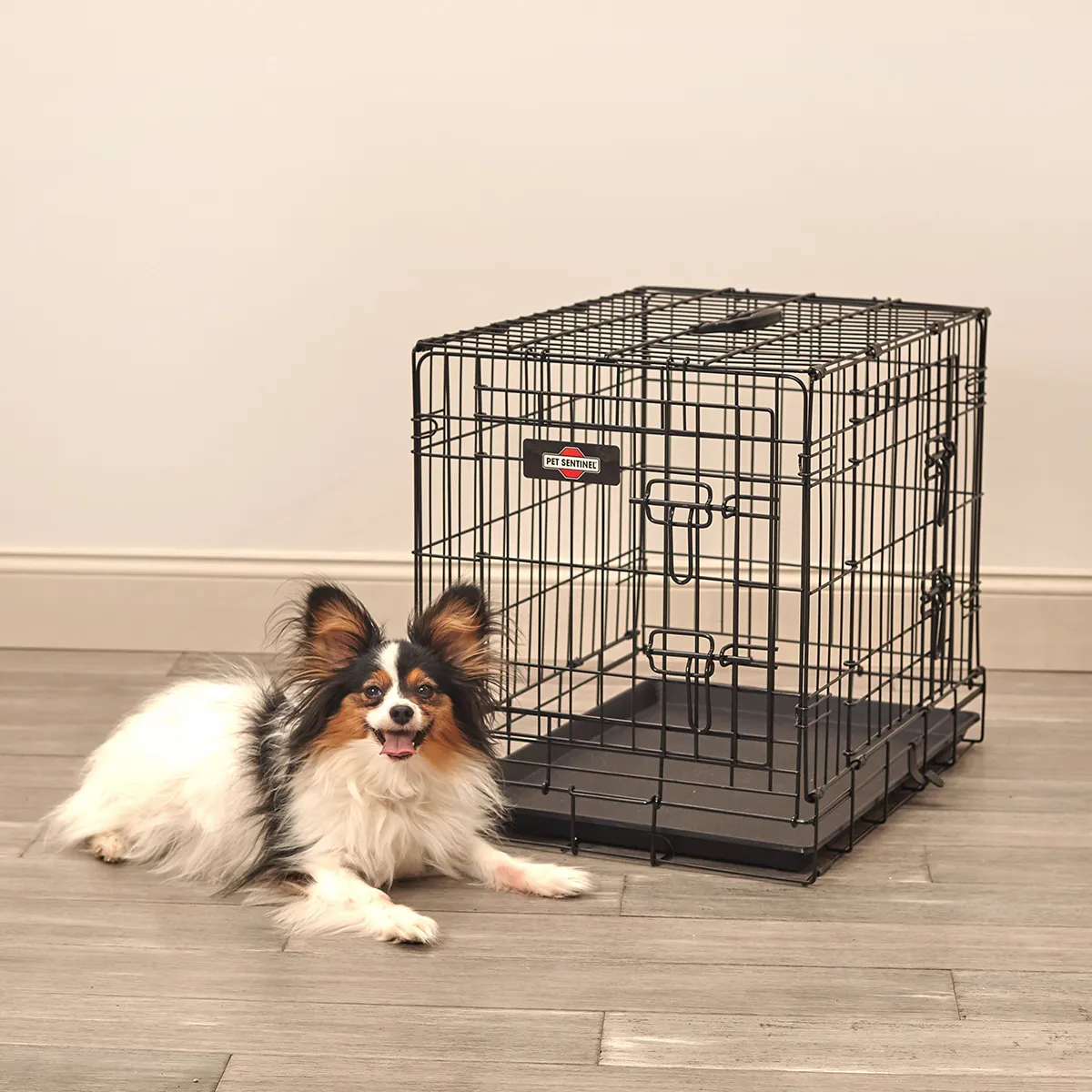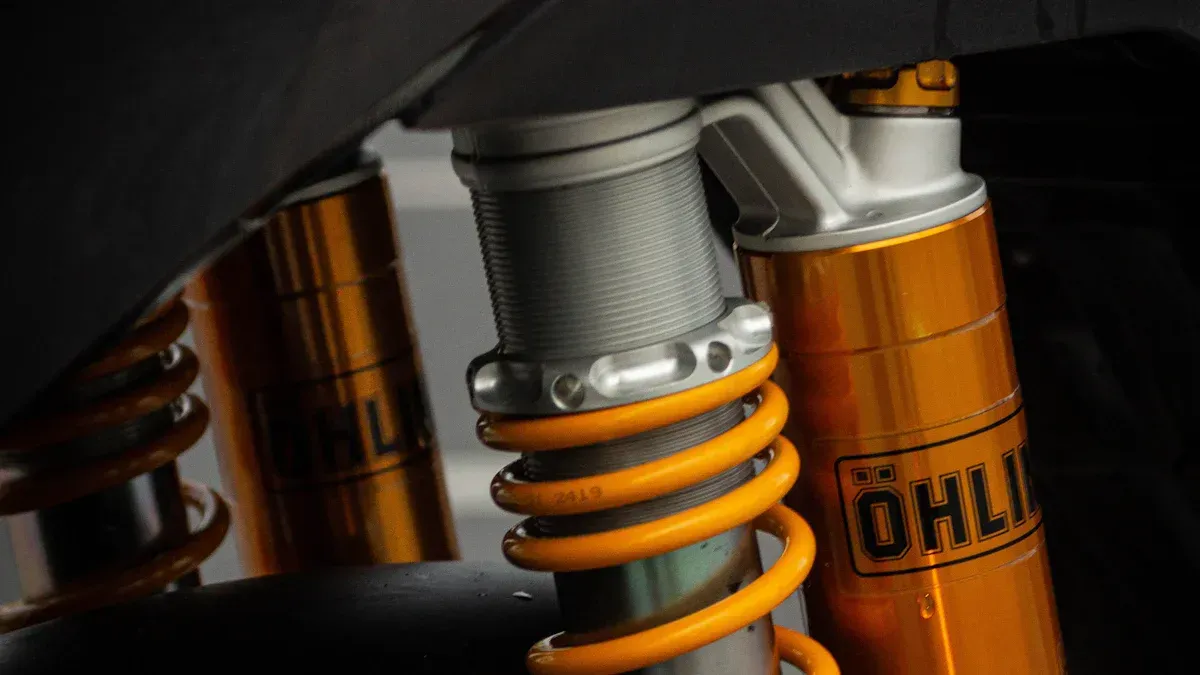Leaf Spring Vs Coil Spring
Jul . 16, 2025 14:06

Leaf springs and coil springs help hold up your trailer in different ways. Blattfeder setups have layers of steel strips for strength and last a long time. Coil springs use spiral coils to give more comfort and bend easily. Picking the right spring is important for safety and how steady your trailer is. It also changes how your trailer moves on bumpy roads. Hebei Minmetals gives good Leaf Spring options for carrying heavy things.
The type of suspension changes how steady your trailer is, how smooth the ride feels, how fast tires wear out, and how safe your cargo is.
Picking the right spring keeps your trailer safe, lowers repair needs, and makes driving more comfortable.
Key Takeaways
Leaf springs are made of metal strips stacked together. They help carry heavy loads and keep trailers steady. This makes them good for hard work and bumpy roads.
Coil springs are shaped like spirals. They soak up bumps well and give a smoother ride. They work best for lighter trailers and vehicles.
Picking the right spring depends on your trailer’s weight, how you use it, and how much comfort you want. This helps keep you safe and makes your trailer work better.
Leaf springs last a long time if you take care of them. They cost more at first but can save money on repairs. Coil springs feel nicer but might need more fixing.
Hebei Minmetals sells strong leaf springs that are simple to put in. They are great for heavy trailers and help keep your things safe and steady.
Difference Between Coil Spring and Leaf Spring
How They Work
Leaf springs and coil springs both support your trailer, but they do it in different ways.
Leaf springs use several flat metal strips stacked together. These strips bend and flex when your trailer hits a bump. The bending spreads the force across the whole spring and the trailer frame. This helps absorb shocks and keeps your trailer stable. Leaf springs also help hold the axle in place, so they act as both a spring and a support.
Coil springs look like a spiral or a helix. When your trailer goes over a bump, the coil spring compresses or stretches. The spring stores energy and then releases it to smooth out the ride. Coil springs focus on absorbing shocks by changing shape, but they do not help hold the axle in place. You need extra parts to keep everything steady.
Tip: Leaf springs are great for heavy loads and rough roads. Coil springs give a smoother ride, especially on lighter trailers.
Key Features
You can spot the differences between leaf springs and coil springs by looking at their structure and what they do best.
| Besonderheit | Blattfeder | Coil Spring |
|---|---|---|
| Shape | Flat, stacked metal strips (arched) | Spiral or helix-shaped wire |
| Main Parts | Main leaf, helper leaves, clamps, eyelets | Single coiled wire |
| Load Support | Handles heavy loads, spreads force | Good for lighter loads, absorbs shocks locally |
| Ride Quality | Stiffer, less flexible, more stable | Smoother, more flexible |
| Extra Parts Needed | Fewer (acts as support and spring) | More (needs extra support parts) |
Leaf springs use several curved steel plates stacked together. The main leaf carries most of the weight, while shorter leaves help spread the load. Clamps hold the leaves together, and eyelets attach the spring to your trailer. This design makes leaf springs strong and reliable for heavy-duty use. Coil springs, on the other hand, use a single piece of coiled wire. They give you a softer ride and work best in lighter trailers or cars.
You should choose the spring that matches your trailer’s needs for the best performance and safety.
Leaf Spring Overview

Structure
When you look at a Leaf Spring, you see several flat metal strips stacked on top of each other. Each strip is called a "leaf." The longest leaf sits at the top, and shorter leaves go underneath. These leaves work together to support your trailer and absorb bumps from the road. Most trailer leaf springs use high-quality steel, such as carbon steel, alloy steel, or spring steel. These materials give the spring strength, flexibility, and resistance to wear. Some modern springs use composite materials, but steel remains the most common choice for trailers.
Hebei Minmetals designs its Leaf Spring products with durability in mind. Each spring uses sturdy spring steel for long-lasting performance. You get nylon bushings with a 9/16 inch inner diameter, which help reduce friction and make the spring last longer. Multiple leaves in the spring allow it to flex and handle rough roads without breaking. You can choose from different models, with options for free length, free arch, and the number of leaves.
Here is a table showing some common types of trailer leaf springs and their load capacities:
| Spring Type | Number of Leaves | Material | Load Capacity (lbs) | Width (in) | Thickness (in) |
|---|---|---|---|---|---|
| Slipper - Radius End | 1 | High-quality steel | 230 | 1.75 | 0.237 |
| Double Eye | 3 | High-quality steel | 1,500 | 1.75 | 0.323 |
| Double Eye | 8 | High-quality steel | 4,000 | 1.75 | 0.360 |
Verwendet
You often find Leaf Spring systems on trailers that carry heavy loads. These springs help keep your trailer stable, even when you drive over rough or uneven roads. The design spreads the weight across the whole spring, which protects your trailer from damage and keeps your cargo safe. Hebei Minmetals offers a wide range of Leaf Spring models, so you can pick the right one for your trailer’s size and weight needs. Many people choose leaf springs for commercial trailers, utility trailers, and even personal-use trailers because they trust the strength and reliability of this suspension system.
Notiz: If you want a suspension that can handle tough jobs and last for years, a Leaf Spring from Hebei Minmetals gives you the support and stability you need.
Coil Spring Overview
Structure
When you look at a coil spring, you see a thick wire twisted into a spiral. This spiral shape lets the spring squeeze and stretch when you hit bumps. That helps soak up shocks from the road. Coil springs are made from many kinds of metal. Most use high carbon steel. Some use chromium vanadium steel, stainless steel, or copper-based alloys. These metals help the spring last longer and fight off rust or heat.
Here is a table that lists the main materials and features of coil springs:
Aspect Details Typical Materials High carbon steel, chromium vanadium steel, stainless steel, silicon manganese steel, copper alloys, nickel alloys Material Properties High strength, fatigue resistance, corrosion resistance, heat resistance, electrical conductivity Design Variations Closed end, square end, open end, pigtail; barrel, conical, variable-rate springs Manufacturing Process Cold winding, hot winding, heat treatment, grinding, shot peening, coatings Functional Impact End types affect fit and durability; coatings protect against rust; special shapes improve performance
Coil springs come in different shapes and end styles. Some have closed ends, while others have open or pigtail ends. The shape and finish help the spring fit better and last longer. Many coil springs get special coatings to stop rust and damage.
Verwendet
You find coil springs in lots of vehicles. Most cars, small trucks, and vans use coil springs in their suspension. These springs help hold up your vehicle and make the ride smoother. Coil springs work well in strut assemblies. They help absorb shocks and keep your car at the right height.
You can find coil springs in:
Passenger cars
Light trucks and vans
Strut-type suspension systems
There are two main kinds of coil springs. Constant rate springs give steady support and help with heavy loads or fast driving. Variable rate springs get stiffer as you add more weight. This helps your vehicle stay level when you carry cargo or tow something.
Coil springs make rides more comfortable and help with handling. They keep your vehicle steady on turns and over bumps. Many car makers use coil springs because they make the ride smoother and safer for everyone.
Comparison
Load Capacity
When you choose a spring for your trailer, load capacity matters most. Leaf springs handle heavy loads very well. You often see them on trailers, trucks, and other vehicles that carry big or heavy items. The design spreads weight across several metal strips, which helps keep your trailer level and stable. Coil springs work best for lighter loads. They use a single coil of metal, which bends and flexes easily. This makes them great for cars and small trailers, but not for hauling heavy cargo.
Tip: If you plan to carry heavy equipment or large loads, leaf springs give you the strength and support you need.
Ride Comfort
You want your trailer to ride smoothly, especially on bumpy roads. Coil springs usually give you a softer, more comfortable ride. Here are some reasons why:
Coil springs let each wheel move up and down on its own. This helps your trailer handle bumps better.
You can pick different coil spring types, like progressive or linear, to change how soft or firm the ride feels.
Coil springs are lighter, which helps your trailer move more smoothly.
Leaf springs hold the axle in place and support the whole trailer. This makes the ride stiffer, especially when the trailer is empty.
Leaf springs work best for heavy-duty jobs, but they do not absorb bumps as well as coil springs.
Note: Some special vehicles use leaf springs in unique ways, but for most trailers, coil springs win for comfort.
Haltbarkeit
You want your suspension to last a long time. Leaf springs have a simple design and strong steel construction. With regular cleaning and checks, they can last over 100,000 miles, especially if you do not overload your trailer. Heavy loads and rough roads can shorten their life, but good care helps them last longer. Coil springs also last a long time, but they can sag or lose height over many years. Coil springs resist rust if they have a good coating, but their more complex design can make repairs harder.
Leaf springs need less maintenance because they have fewer parts.
Coil springs may need more attention, especially if you want to keep the ride smooth.
Cost
Cost is important when you pick a suspension system. Here is a table that shows the average costs for buying and installing each type:
Spring Type Total Average Cost (Parts + Labor) Labor Cost Range Parts Cost Range Leaf Springs $450 to $790 $95 to $170 $355 to $620 Coil Springs $350 to $422 $133 to $168 $217 to $254
Leaf springs cost more to buy and install than coil springs. The parts for leaf springs are more expensive, but labor costs are a bit lower. Coil springs cost less overall, but you may pay more for labor because the installation can be tricky. Leaf springs are easy to find and replace, which helps keep repair costs down over time. Coil springs have more parts, so repairs can cost more if something goes wrong.
Remember: Leaf springs are a smart choice if you want strength, durability, and easy repairs. Coil springs are better if you want a smoother ride and lower upfront costs.
Pros and Cons
Blattfeder
When you look at a Leaf Spring, you see a simple and strong design. Many people choose this type for trailers and heavy vehicles. Here are some main pros and cons:
You get a simple and robust construction. This makes repairs and replacements easy.
Leaf springs offer high load capacity. They work well for heavy trailers and trucks.
The cost to make and buy leaf springs is lower than other suspension types.
The ride can feel bumpy. You may notice more vibration because the spring is stiff.
Over time, metal fatigue can cause the spring to sag or lose shape.
Leaf springs do not absorb shocks as well as coil springs. You might feel more bumps on rough roads.
During acceleration or turning, you may notice more movement in the trailer’s frame.
Tip: If you need to carry heavy loads and want a tough, budget-friendly option, a Leaf Spring is a smart choice.
Coil Spring
Coil springs use a spiral shape to give you a smoother ride. Many cars and light trailers use this type. Here is a table that shows the main pros and cons:
Pros Cons Greater flexibility and comfort. Coil springs help absorb bumps and potholes, giving you a smoother ride. Can be expensive. Coil spring setups have more parts and often need professional installation. Customizability. You can change or upgrade parts to fit your driving needs, like off-roading or performance. Not suitable for heavy vehicles. Coil springs may break or crack under heavy loads, especially if they rust. Enhanced performance and off-road ability. Coil springs improve handling and let your trailer or vehicle move better over rough ground. Note: Coil springs work best for lighter loads and when you want a comfortable ride.
Choosing Springs
Factors
When you pick a spring for your trailer, you need to look at several important factors. Each type of spring has strengths and weaknesses. You want to match the spring to your trailer’s needs for the best performance and safety.
Here is a table that compares the main factors for leaf springs and coil springs:
Factor Leaf Springs Coil Springs Load-bearing capacity Excellent for heavy loads; spreads load over broad area Less stable for heavy-duty load carrying Ride quality Limited; often rough or bouncy, especially when empty Superior; better ride comfort and off-road agility Suspension travel Limited More suspension movement allowed Adjustability Minimal; fixed mounting points limit customization High; options for progressive, linear, or dual rates Cost Cost-effective and simple More expensive with additional supporting parts Haltbarkeit Very durable; can last vehicle lifetime Durable but may require more maintenance Handling under load Stability improves with load; rising rate beneficial Requires additional linkage for axle guidance
You should think about these points before making a choice:
Leaf springs work well if you need to carry heavy loads. They spread the weight and keep your trailer stable.
Coil springs give you a smoother ride. They work best for lighter loads and when comfort matters most.
Leaf springs have a simple design. They guide the axle and act as the spring at the same time. This makes them easy to maintain.
Coil springs need extra parts to keep the axle in place. This can make the system more complex and costly.
If you want to adjust your suspension for different loads, coil springs offer more options. You can pick from different rates and even add air shocks for more control.
Leaf springs last a long time and need less maintenance. Coil springs may need more care, especially if you use your trailer often.
Tip: Always check your trailer’s load rating and how you plan to use it. The right spring keeps your trailer safe and helps it last longer.
Anwendung
You need to match your spring choice to how you use your trailer. The type of cargo, the roads you travel, and how often you use your trailer all matter.
Leaf springs fit best on trailers, trucks, and commercial vehicles. You see them on equipment haulers, utility trailers, and cargo trailers. Their strong, multi-layered design spreads heavy loads and keeps your trailer level. If you drive on rough roads or carry heavy items, leaf springs give you the stability and durability you need.
Coil springs work better for lighter vehicles and trailers. You find them on cars, small vans, and some light-duty trailers. They give a softer ride, which is great for carrying fragile items or when comfort is important. Coil springs also help if you drive mostly on smooth roads.
You should also think about how often you use your trailer. If you use it every day for tough jobs, leaf springs handle the stress and last longer. If you use your trailer for lighter loads or only once in a while, coil springs may give you the comfort you want.
Notiz: For most heavy-duty trailers, leaf springs are the top choice. They keep your trailer balanced, even when fully loaded, and stand up to rough terrain. Coil springs are better for comfort and lighter loads, but they may not hold up as well under heavy use.
Choosing the right spring helps you get the best performance from your trailer. Look at your needs, check your load, and pick the spring that matches your job. This way, you keep your trailer safe and your cargo secure every time you hit the road.
Hebei Minmetals Leaf Spring
Benefits
You want your trailer to stay stable and safe on every trip. Hebei Minmetals Leaf Spring gives you that peace of mind. The strong spring steel construction helps your trailer handle heavy loads without bending or breaking. You get excellent shock absorption, so your cargo stays protected even on rough roads. The nylon bushings reduce friction and wear, which means your suspension lasts longer. Multiple leaves in each spring work together to keep your trailer level and steady. You can use these springs on many types of trailers, from utility trailers to equipment haulers. This flexibility makes them a smart choice for many jobs.
Tip: Choose the right model for your trailer’s weight. Hebei Minmetals offers springs with load capacities from 1,000 to 4,000 pounds.
Why Choose
You should pick Hebei Minmetals Leaf Spring if you want a reliable and easy-to-install suspension solution. The springs come in different sizes and shapes, so you can match them to your trailer’s needs. Each model lists its free length, free arch, and number of leaves. You only need basic tools and a hanger kit to install them. The design fits most trailer frames and axles. You get a product that stands up to daily use and tough conditions. Many trailer owners trust Hebei Minmetals for long-lasting performance and safety.
Stable ride for heavy and light trailers
Durable materials for long service life
Smooth shock absorption for cargo protection
Easy installation with clear specs
Note: Always check your trailer’s requirements before choosing a spring. The right fit keeps your trailer safe and your trips worry-free.
You can see the main differences between spring types in the table below:
Aspect Leaf Springs Coil Springs Load Capacity High, for heavy trailers Lower, for lighter vehicles Ride Comfort Stiffer ride Smoother ride Maintenance Simple and cost-effective Needs more checks and adjustments
To choose the right spring for your trailer, follow these steps:
- Check your trailer’s axle weight rating.
- Inspect springs for wear or damage.
- Match the spring type to your trailer’s load and use.
Hebei Minmetals springs help you keep your trailer stable and safe on every trip.
Leaf Spring FAQ
What is the main job of a leaf spring on a trailer?
A leaf spring holds up your trailer and keeps it stable. It spreads the weight and absorbs bumps from the road. You get a safer and smoother ride for your cargo.
Can you replace coil springs with leaf springs on a trailer?
You cannot easily swap coil springs for leaf springs. Each spring type needs a different suspension setup. You should use the spring type your trailer was designed for.
How do you know when to replace your trailer’s leaf springs?
Look for signs like sagging, cracks, or rust. If your trailer rides unevenly or makes noise, check the springs. Replace them if you see damage or if your trailer does not stay level.
Do leaf springs need a lot of maintenance?
You do not need much maintenance for leaf springs. Check them for rust and damage. Clean them and make sure bolts stay tight. Regular checks help your springs last longer.
Which spring type gives a smoother ride?
Coil springs usually give you a smoother ride. They absorb bumps better and make the trailer feel softer on rough roads. Leaf springs feel stiffer but work better for heavy loads.

Durchlässig
Dies ist der erste Artikel








 Einheit
Einheit Schaffung
Schaffung Herausforderung
Herausforderung Beitrag
Beitrag










